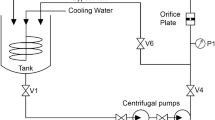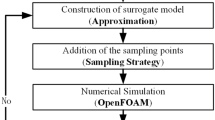Abstract
We investigated the influence of geometrical parameters of the orifice plate on the cavitation structures, and optimized these parameters by using a surrogate-based model with special emphasis on the concentration of hydroxyl radical released. The results show that for the orifice plate of the hydrodynamic cavitation system, the possible location of the inception of the cavity spreads to throat and divergent section of the venturi geometry. Based on the surrogate model and global sensitivity assessment, the diameter of throat D t and diameter of inlet D in significantly influenced the size of the cavity, while the length of throat L t had little effect on both cavitation intensity and flow rate. It should be noted that when L t is decreased, the size of cavity would be slightly decreased but the flow rate increased clearly. The increase of the diverging section is in favor of the size of cavity. By comparing the experimental measurements on the concentration of Methylene blue, the optimum geometry of the orifice plate for best cavitational activity is proposed.
Similar content being viewed by others
References
I. Oller, S. Malato and J. A. Sánchez-Pérez, Combination of advanced oxidation processes and biological treatments for wastewater decontamination—a review, Science of the Total Environment, 409 (20) (2011) 4141–4166.
C. Bougrier, J. P. Delgenes and H. Carrere, Impacts of thermal pre-treatments on the semi-continuous anaerobic digestion of waste activated sludge, Biochemical Engineering J., 34 (1) (2007) 20–27.
P. R. Gogate and A. B. Pandit, A review of imperative technologies for wastewater treatment I: oxidation technologies at ambient conditions, Advances in Environmental Research, 8 (3) (2004) 501–551.
P. R. Gogate and A. B. Pandit, A review of imperative technologies for wastewater treatment II: hybrid methods, Advances in Environmental Research, 8 (3) (2004) 553–597.
X. Liu et al., Enhancement of solubilization and acidification of waste activated sludge by pretreatment, Waste Management, 28 (12) (2008) 2614–2622.
T. H. Kim et al., Disintegration of excess activated sludge by hydrogen peroxide oxidation, Desalination, 246 (1) (2009) 275–284.
D. H. Kim et al., Combined (alkaline+ ultrasonic) pretreatment effect on sewage sludge disintegration, Water Research, 44 (10) (2010) 3093–3100.
J. Kim, Y. Yu and C. Lee, Thermo-alkaline pretreatment of waste activated sludge at low-temperatures: effects on sludge disintegration, methane production, and methanogen community structure, Bioresource Technology, 144 (2013) 194–201.
G. Su et al., Hydrolysis, acidification and dewaterability of waste activated sludge under alkaline conditions: combined effects of NaOH and Ca(OH)2, Bioresource Technology, 136 (2013) 237–243.
M. V. Bagal and P. R. Gogate, Wastewater treatment using hybrid treatment schemes based on cavitation and Fenton chemistry: a review, Ultrasonics Sonochemistry, 21 (1) (2014) 1–14.
C. G. Joseph et al., Sonophotocatalysis in advanced oxidation process: A short review, Ultrasonics Sonochemistry, 16 (5) (2009) 583–589.
K. P. Mishra and P. R. Gogate, Intensification of degradation of Rhodamine B using hydrodynamic cavitation in the presence of additives, Separation and Purification Technology, 75 (3) (2010) 385–391.
V. K. Saharan et al., Hydrodynamic cavitation as an advanced oxidation technique for the degradation of Acid Red 88 dye, Industrial & Engineering Chemistry Research, 51 (4) (2011) 1981–1989.
M. Cai et al., Decolorization of azo dyes Orange G using hydrodynamic cavitation coupled with heterogeneous Fenton process, Ultrasonics Sonochemistry, 28 (2016) 302–310.
C. E. Brennen, Cavitation and bubble dynamics, Oxford University Press (1995).
K. S. Suslick, M. M. Mdleleni and J. T. Ries, Chemistry induced by hydrodynamic cavitation, J. of the American Chemical Society, 119 (39) (1997) 9303–9304.
P. R. Gogate et al., Cavitation reactors: efficiency assessment using a model reaction, AIChE J., 47 (11) (2001) 2526–2538.
L. H. Thompson and L. K. Doraiswamy, Sonochemistry: science and engineering, Industrial & Engineering Chemistry Research, 38 (4) (1999) 1215–1249.
K. W. Jung et al., Development of a novel electric fieldassisted modified hydrodynamic cavitation system for disintegration of waste activated sludge, Ultrasonics Sonochemistry, 21 (5) (2014) 1635–1640.
P. R. Gogate and A. B. Pandit, A review and assessment of hydrodynamic cavitation as a technology for the future, Ultrasonics Sonochemistry, 12 (1) (2005) 21–27.
P. S. Kumar, M. S. Kumar and A. B. Pandit, Experimental quantification of chemical effects of hydrodynamic cavitation, Chemical Engineering Science, 55 (9) (2000) 1633–1639.
X. W. Luo, J. Bin and Y. Tsujimoto, A review of cavitation in hydraulic machinery, J. of Hydrodynamics, 28 (3) (2016) 335–358.
P. R. Gogate and P. N. Patil, Combined treatment technology based on synergism between hydrodynamic cavitation and advanced oxidation processes, Ultrasonics Sonochemistry, 25 (2015) 60–69.
C. Minero et al., Fe (III)-enhanced sonochemical degradation of methylene blue in aqueous solution, Environmental Science & Technology, 39 (22) (2005) 8936–8942.
R. Chand et al., Water disinfection using the novel approach of ozone and a liquid whistle reactor, Biochemical Engineering J., 35 (3) (2007) 357–364.
A. A. Pradhan and P. R. Gogate, Removal of p-nitrophenol using hydrodynamic cavitation and Fenton chemistry at pilot scale operation, Chemical Engineering J., 156 (1) (2010) 77–82.
L. P. Amin et al., Optimization of a hydrodynamic cavitation reactor using salicylic acid dosimetry, Chemical Engineering J., 156 (1) (2010) 165–169.
R. K. Joshi and P. R. Gogate, Degradation of dichlorvos using hydrodynamic cavitation based treatment strategies, Ultrasonics Sonochemistry, 19 (3) (2012) 532–539.
C. D. Wu et al., Effects of operating parameters and additives on degradation of phenol in water by the combination of H2O2 and hydrodynamic cavitation, Desalination and Water Treatment, 53 (2) (2015) 462–468.
A. L. Prajapat and P. R. Gogate, Intensification of depolymerization of aqueous guar gum using hydrodynamic cavitation, Chemical Engineering and Processing: Process Intensification, 93 (2015) 1–9.
Y. Wang et al., Disinfection of bore well water with chlorine dioxide/sodium hypochlorite and hydrodynamic cavitation, Environmental Technology, 36 (4) (2015) 479–486.
V. K. Saharan et al., Effect of geometry of hydrodynamically cavitating device on degradation of orange-G, Ultrasonics Sonochemistry, 20 (1) (2013) 345–353.
N. P. Vichare, P. R. Gogate and A. B. Pandit, Optimization of hydrodynamic cavitation using a model reaction, Chemical Engineering & Technology, 23 (8) (2000) 683–690.
T. A. Bashir et al., The CFD driven optimization of a modified venturi for cavitational activity, The Canadian J. of Chemical Engineering, 89 (6) (2011) 1366–1375.
B. Ji et al., Large eddy simulation and theoretical investigations of the transient cavitating vortical flow structure around a NACA66 hydrofoil, International J. of Multiphase Flow, 68 (2015) 121–134.
X. X. Peng et al., Combined experimental observation and numerical simulation of the cloud cavitation with U-type flow structures on hydrofoils, International J. of Multiphase Flow, 79 (2016) 10–22.
T. Chen, B. Huang and G. Wang, Numerical study of cavitating flows in a wide range of water temperatures with special emphasis on two typical cavitation dynamics, International J. of Heat and Mass Transfer, 101 (2016) 886–900.
B. Huang et al., Combined experimental and computational investigation of unsteady structure of sheet/cloud cavitation, Journal of Fluids Engineering, 135 (7) (2013) 071301.
F. R. Menter, Improved two-equation k-omega turbulence models for aerodynamic flows, NASA Technical Memorandum, 34 (1992).
T. Chen et al., Effects of fluid thermophysical properties on cavitating flows, J. of Mechanical Science and Technology, 29 (10) (2015) 4239–4246.
B. Huang, Y. Zhao and G. Wang, Large eddy simulation of turbulent vortex-cavitation interactions in transient sheet/cloud cavitating flows, Computers & Fluids, 92 (2014) 113–124.
Q. Wu et al., Experimental and numerical investigation of hydroelastic response of a flexible hydrofoil in cavitating flow, International J. of Multiphase Flow, 74 (2015) 19–33.
S. Park and S. H. Rhee, Comparative study of incompressible and isothermal compressible flow solvers for cavitating flow dynamics, J. of Mechanical Science and Technology, 29 (8) (2015) 3287–3296.
A. Kubota, H. Kato and H. Yamaguchi, A new modelling of cavitating flows: a numerical study of unsteady cavitation on a hydrofoil section, J. of Fluid Mechanics, 240 (1992) 59–96.
L. W. A. De Silva and H. Yamaguchi, Numerical study on active wave devouring propulsion, Journal of Marine Science and Technology, 17 (3) (2012) 261–275.
R. H. Myers, Response surface methodology—current status and future directions, J. of Quality Technology, 31 (1) (1999) 30.
M. D. McKay, R. J. Beckman and W. J. Conover, A comparison of three methods of selecting values of input variables in the analysis of output from a computer code, Technometrics, 21 (1979) 239–245.
G. Matheron, Principles of Geostatistics, Economic Geology, 58 (1963) 1246–1266.
M. J. L. Orr, Introduction to radial basis function networks, Center for Cognitive Science, Edinburg University, EH 9LW, Scotland, UK (1996).
T. Goel et al., Ensemble of surrogates, J. of Structural and Multidisciplinary Optimization, 33 (3) (2007) 199–216.
J. Soubiran and J. D. Sherwood, Bubble motion in a potential flow within a Venturi, International J. of Multiphase Flow, 26 (11) (2000) 1771–1796.
W. Shyy et al., Surrogate-based modeling and dimension reduction techniques for multi-scale mechanics problems, Acta Mechanica Sinica, 27 (6) (2011) 845–865.
B. Huang, W. Qin and G. Wang, Numerical investigation of cavitating flow in liquid hydrogen, International J. of Hydrogen Energy, 39 (4) (2014) 1698–1709.
V. S. Moholkar and A. B. Pandit, Bubble behavior in hydrodynamic cavitation: effect of turbulence, AIChE Journal, 43 (6) (1997) 1641–1648.
P. S. Kumar and A. B. Pandit, Modeling hydrodynamic cavitation, Chemical Engineering & Technology, 22 (12) (1999) 1017–1027.
V. S. Moholkar, P. S. Kumar and A. B. Pandit, Hydrodynamic cavitation for sonochemical effects, Ultrasonics Sonochemistry, 6 (1) (1999) 53–65.
Y. Huang et al., Degradation of chitosan by hydrodynamic cavitation, Polymer Degradation and Stability, 98 (1) (2013) 37–43.
D. Ghayal, A. B. Pandit and V. K. Rathod, Optimization of biodiesel production in a hydrodynamic cavitation reactor using used frying oil, Ultrasonics Sonochemistry, 20 (1) (2013) 322–328.
G. V. Buxton et al., Critical review of rate constants for reactions of hydrated electrons, hydrogen atoms and hydroxyl radicals (· OH/· O-in aqueous solution, J. of Physical and Chemical Reference Data, 17 (2) (1988) 513–886.
K. Zhang et al., Comparison of catalytic activities for photocatalytic and sonocatalytic degradation of methylene blue in present of anatase TiO2-CNT catalysts, Ultrasonics Sonochemistry, 18 (3) (2011) 765–772.
M. Roosta et al., Optimization of the ultrasonic assisted removal of methylene blue by gold nanoparticles loaded on activated carbon using experimental design methodology, Ultrasonics Sonochemistry, 21 (1) (2014) 242–252.
X. Zhang, H. Yang and Z. Li, Relationship between strength of hydrodynamic cavitation and amount of induced hydroxyl radical, J. of Chemical Industry and Engineering-China, 58 (1) (2007) 27.
N. Shimizu et al., Sonocatalytic degradation of methylene blue with TiO2 pellets in water, Ultrasonics Sonochemistry, 14 (2) (2007) 184–190.
D. Kobayashi et al., Effects of ultrasonic frequency and initial concentration on degradation of methylene blue, Japanese J. of Applied Physics, 53 (7S) (2014) 07KE03.
X. Zhang et al., The collapse intensity of cavities and the concentration of free hydroxyl radical released in cavitation flow, Chinese J. of Chemical Engineering, 16 (4) (2008) 547–551.
J. Deng and J. Zhou, Experimental study of the porous plate hydrodynamic cavitation device and removal the algae in water, Advanced Materials Research. Trans Tech Publications, 800 (2013) 569–572.
Author information
Authors and Affiliations
Corresponding author
Additional information
Recommended by Associate Editor Shin Hyung Rhee
Xianlin Li received his B.S. in Vehicle Engineering from Beijing Forestry University, China, in 2014. He is a graduate student in Mechanical Engineering, Beijing Institute of Technology, majoring in fluid dynamics. His research interests include hydrodynamic cavitation and hydraulic machinery.
Rights and permissions
About this article
Cite this article
Li, X., Huang, B., Chen, T. et al. Combined experimental and computational investigation of the cavitating flow in an orifice plate with special emphasis on surrogate-based optimization method. J Mech Sci Technol 31, 269–279 (2017). https://doi.org/10.1007/s12206-016-1229-8
Received:
Revised:
Accepted:
Published:
Issue Date:
DOI: https://doi.org/10.1007/s12206-016-1229-8




